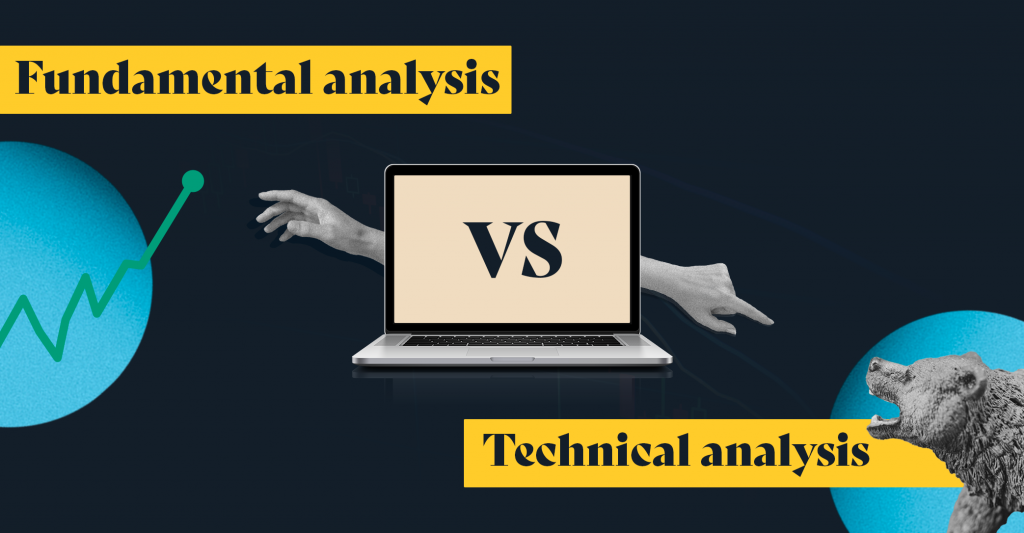Last Updated on May 27, 2021 by Manonmayi
Stock investment is a game of prediction and risk aversion. To win this game, or any game, you must understand everything about it. You require a thorough analysis of everything from the players to the field. The 2 major methods of analysis are fundamental analysis and technical analysis.
This article covers:
Table of Contents
Fundamental analysis
This method of stock analysis is used to find the intrinsic value of a share instead of its current market value. It helps determine your investment decisions. For example, if a fundamental analysis of Reliance’s stock reveals that its stock price should be higher (around Rs 2,500) than its 27th Mar 2021 rate of Rs 1,994.25, then you could buy it before the market catches up and make good returns. If the value is lower, then it would be better to consider selling it before the value eventually drops as predicted.
Fundamental analysis uses 2 methods to determine a share’s intrinsic value. They are quantitative and qualitative fundamental analysis.
1. Quantitative fundamental analysis
This method of fundamental analysis uses data such as a company’s financial reports like its balance sheet, income, and cash flow statements to arrive at an intrinsic value.
2. Qualitative fundamental analysis
This method attributes an intrinsic value to a stock using dispositional factors like its business model, competitive advantages, management team, corporate policies, and the industry it operates in.
Fundamental analysis is the most suitable way to shortlist stocks for a long-term investment. You can use Tickertape’s stock screener with filters like P/E ratio, profitability, and multiple sub-filters for quantitative analysis. And filters like ownership, market cap, and stock universe for qualitative analysis to pick your best stocks.
Technical analysis
Technical analysis is a method that utilises the economic principles of pricing and volume and their fluctuations and movements to predict the future value of a stock. It predicts stock value using several key factors as mentioned below.
1. Market discounts everything
Technical analysis assumes that the current value of a stock is already an indicator of a company’s fundamentals. The only analysis required is one focused on price movement.
2. Stock prices
Technical analysis uses trends and past patterns of a stock as an indicator of how it moves forward in the future. For example, a technical analyst would likely predict that Yes Bank’s shares will continue to decline and assign a future value similar to its current performance.
3. Repetitive history
As an investor, a particular stock’s potential might excite you while another’s performance could worry you. Fear and excitement are 2 of many market emotions that have been constant throughout history. Technical analysis believes they repeat themselves.
4. Momentum
Momentum measures the speed of a stock price and how it increases or decreases over time. Technical analysis examines momentum over a particular period to predict future stock prices.
5. Volume
Volume is the number of shares of a stock that trade over a certain period, usually a day. Technical analysis uses a stock’s volume to identify the strength of a price movement and other trends. This is done by displaying the number of shares being traded in a particular direction, usually as a bar chart.
Other key factors in technical analysis include support and resistance, moving averages, indicators and oscillators. You can use Tickertape’s stock screener with its wide range of filters, including EMAs, 1-year max loss, and super trend to have a go at predicting the future of your preferred stocks.
Fundamental analysis vs technical analysis
Intrinsic value
Fundamental analysis (FA) predicts a company’s intrinsic value which is a derived stock price that is not the current market price. In contrast, technical analysis (TA) predicts the future price of a stock.
For example, you would look at Bajaj Finance’s final reports, management team, and similar factors to reach an intrinsic value. However, you would use the company’s 26th Mar 2021 stock price of Rs 5,173.05 and past 5 yr performance to predict its rise/fall. Tickertape’s stock pages give information on a company’s financials, corporate actions, peers, and more to help you predict this better.
Focus
Fundamental analysis gives a large weightage to company policy and results on the impact of a stock price, while technical analysis believes the impact is already built into the current value. For the former, you would assess factors like the management and the corporate governance failure of Yes Bank, while you will begin your technical analysis knowing that the current stock value already reflects Yes Bank’s fundamentals.
Method
In fundamental analysis, you use the fundamentals qualities/quantities of a company like management, revenue, assets and so on to arrive at a value. At the same time, you study stock charts, trends, and patterns in technical analysis. For instance, you would look at Facebook’s balance sheet for the former and the rise of stocks in digital media for the latter.
Information
You could use factors in the market movement and new information arising from it for fundamental analysis and draw on historical performance for technical analysis. For example, you would look at the stock prices of newly-formed PSUs for the former and understand PSUs’ historical stock performances for the latter.
Here are 5 key points to remember about these methods:
| Fundamental Analysis | Technical analysis |
| Analyses company fundamentals to arrive at intrinsic value | Assumes the company’s stock price reflects fundamentals and predicts its future |
| Focuses more on internal factors like management and financial reports | Focuses more on external factors like price and volume |
| Uses balance sheets, income statements and other financial statements for analysis | Uses stock charts, trends and patterns for analysis |
| Factors in new market information | Relies on the repetition of history |
| Originated in the 1930s | Originated in the 1800s |
Both these methods have their associated risks, with fundamental analysis primarily used for long-term investment and technology for short-term investment. It’s better to keep in mind that the investment game is a constant learning process even for established analysts and prepare yourself to face layered, and sometimes risky, stock analysis challenges.







